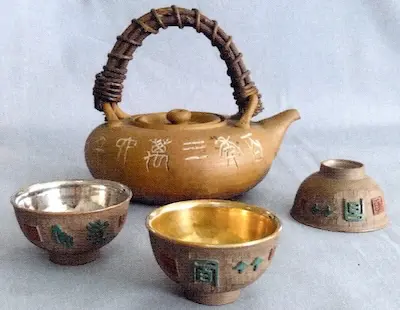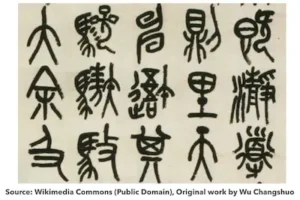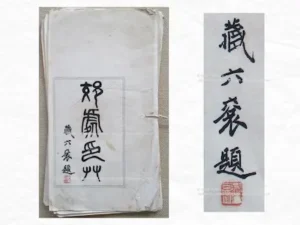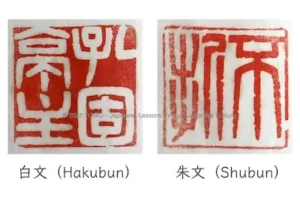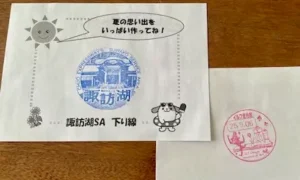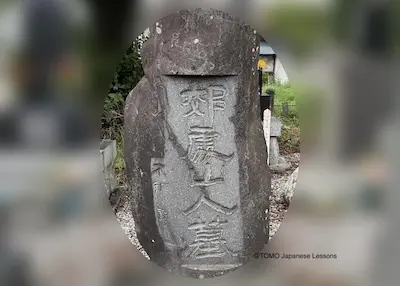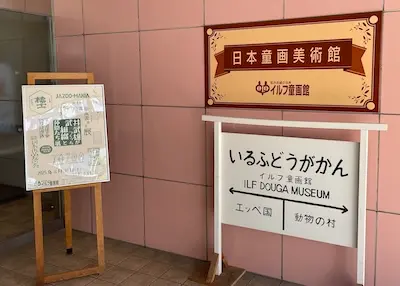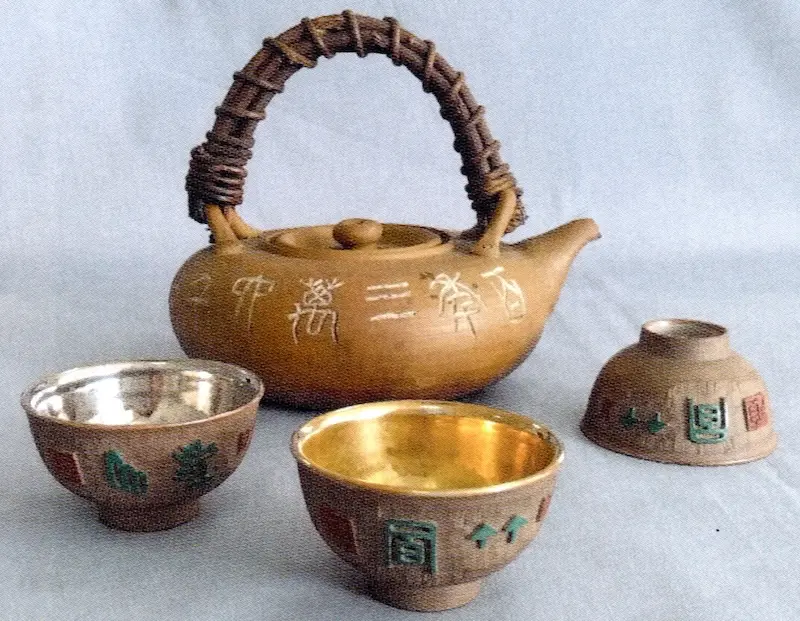
※パンフレットよりスキャンした画像です
Kōsho: His Life, Personality, and Art
As Kōsho lived, the Japanese government introduced Western studies.
As a result, Chinese classics began to decline.
Yet, Chinese learning was vital for the making of modern Japan.
Kōsho also studied Chinese classics.
The reason was his brilliant cousin, Hyōko.
Information was limited in those days.
Therefore, his cousin’s presence carried great weight.
What he learned from Hyōko became the basis of his character and works.
In his late twenties, he studied under Godai Hamamura Zōroku.
From there, he began his path in seal engraving.
Later, he created engraved ceramics and inscribed plaques.
Furthermore, he engraved seals for famous writers and plaques for well-known figures.
Kōsho’s Personality and Artistic Spirit(人柄:ひとがら)
According to stories from my grandfather and father, Kōsho loved sake.
He often gathered with friends.
And while drinking, they talked about art.
He also traveled freely, following his heart.
He met many literary figures.
Sometimes he did not return home for six months or even a year.
Moreover, he nurtured the next generation of artists.
In fact, many artists were born in the region where Kōsho grew up.
Kōsho’s Works: Seal Engraving and Beyond
Seal engraving is the art of carving characters into stone or wood to create an impression.
Because it uses ancient seal script, it is called “tenkoku” in Japanese.
Kōsho’s Works
Kōsho left behind many works.
I would like to introduce them little by little in this blog.
Broadly, there are four main categories:
- Seals
- Calligraphy
- Inscribed plaques
- Engraved ceramics, etc.
Engraved Ceramics
Today, let me show you one type: engraved ceramics.
Engraved ceramics are pottery pieces marked with seal engraving.
Drinking Vessels
The photos in this article are from my family’s storage.
They are drinking vessels for sake.
One is a small teapot used to warm sake.
The other is a chawan cup used for drinking.
The chawan is decorated inside with gold and silver.
This creates a striking contrast with the engraved characters outside.
It is truly a work that reflects Kōsho’s love for sake.
Drinking from this vessel must have made the sake taste even better.
Next Episode Preview
Next time, I will share an episode about a children’s illustrator whom Kōsho cherished like a son : Takei Takeo and Kōsho: The Cultural Legacy of Dōga Art
Discover more about Kōsho’s work at his grave, including inscriptions by Fusetsu and seals by Kōsho.
My articles on my ancestor Kōsho, Natsume Sōseki, seals, and more highlight history and tradition.
→ To explore more about this legacy, please visit the Seal Legacy category
Japanese of the Day / 今日の日本語
- Word:人柄(hitogara) – character; personality
- Meaning:a person’s character, personality
- Example:彼の人柄は多くの人に愛されています。(Kare no hitogara wa ōku no hito ni aisarete imasu.)
(His personality is loved by many people.) - Fun Fact:
The word 人柄 (hitogara) originally comes from the idea of a “pattern on fabric.” Just like fabric has its unique design, people show their unique personality or atmosphere on the outside.
Would you like to experience traditional Japanese culture?
Just like in the story I shared, you can explore Japan’s long-standing cultural traditions with me
in my upcoming “Japanese Culture Course”. Stay tuned!
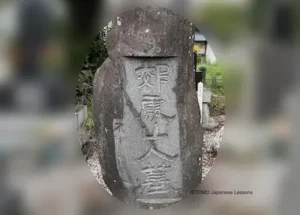
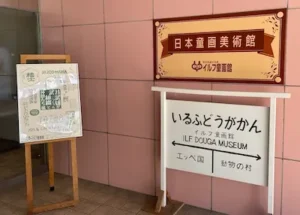
経歴
郊処が生きた時代、政府は西洋学問を導入しました。そして、漢学は衰退の傾向が見られました。
しかし、漢学は近代の日本の形成に欠かせないものでした。
郊処もまた、漢学を学びました。きっかけは聡明な従兄弟、氷湖(ひょうこ)の存在です。
今とは違い、限られた情報の中で、その従兄弟の存在は大きなものだったと考えられます。
彼から学んだことが、郊処の人柄や作品の基盤となっていきました。
また、20代後半から五代浜村蔵六に師事し、篆刻の道へと進みました。
その後、篆刻陶器、篆刻額、有名作家の印章、有名人の額を篆刻などを手掛けました。
人柄
私の祖父や父から聞いた話では、郊処は日本酒が大変好きだったようです。いつも友人と集まり、お酒を飲みながら、芸術について語っていました。
また、心のままに各地を遊歴しました。多くの文人と交流があり、家に半年や1年帰らないこともあったと言います。
そして、次世代の芸術家を育てました。郊処の育った地域は多くの芸術家が誕生しました。
作品紹介
まず、篆刻とは、石や木に文字を彫って印象を作る技術です。字体に篆書が使われるため、「篆刻」と呼ばれます。
郊処は多くの作品を残しました。このブログで少しずつ紹介したいと持っています。まず、種類です。大きく分けて、4つあります。
- 印鑑
- 書
- 篆刻額
- 篆刻陶器 など
その中でも今日は、篆刻陶器をご紹介します。
篆刻陶器とは、陶器に篆刻を施したものです。
記事の写真ですが、我が家の倉に眠っていたものです。これは日本酒を飲むための酒器です。
日本酒を温める急須と、飲むために使う茶碗酒です。
茶碗酒は内側に金と銀に塗られていて、外側の文字との対比がおもしろい作品です。
酒好きな郊処ならではの作品です。この酒器で飲むお酒は、さぞかしおいしかったことでしょう。
次回予告
次回は息子のようにかわいがった童画作家 武井武雄氏とのエピソードをご紹介します。
郊処の作品が見られるお墓の記事もご覧ください。不折による刻字と郊処の印章が紹介されています。
先祖の郊処(こうしょ)、夏目漱石、そして印章などに関する記事は、印章文化の歴史と伝統を紹介しています。
→ 印章の世界をさらに知りたい方は、Seal Legacy category をご覧ください。

